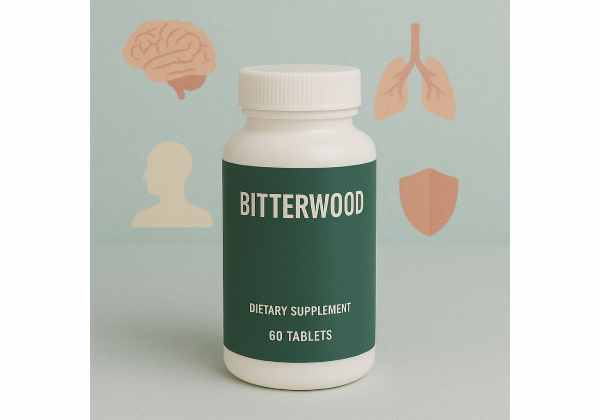Bitterwood, scientifically known as Quassia amara or Picrasma excelsa, is a remarkable tree native to Central and South America and the Caribbean. It is highly prized for its intensely bitter wood and bark, which have long been used in traditional herbal medicine. Bitterwood is famed for its digestive-stimulating, anti-parasitic, and appetite-boosting properties, and is often featured in herbal tonics, bitters, and modern supplements. Today, wellness seekers and herbalists are rediscovering bitterwood for its potential to support healthy digestion, promote gut balance, and provide natural remedies for various ailments. Whether you’re exploring plant-based digestive health or seeking a natural approach to occasional appetite or gut complaints, understanding bitterwood’s benefits, uses, and safety profile will empower you to make the best choices for your health.
Key Takeaways
- Bitterwood is best known for supporting digestion, stimulating appetite, and helping to expel intestinal parasites.
- Its main active compounds are quassinoids, which give bitterwood its distinctive taste and health effects.
- Traditionally used as a herbal tonic, bitterwood is now found in capsules, tinctures, and digestive bitters.
- Safety is high at typical doses, but concentrated extracts or excessive use may cause side effects.
- Consult a healthcare provider before use, especially if you are pregnant, breastfeeding, or have chronic health conditions.
Table of Contents
- Bitterwood Plant Profile: History and Unique Characteristics
- Bioactive Constituents and How Bitterwood Affects the Body
- Top Evidence-Based Benefits and Applications of Bitterwood
- Bitterwood Safety Considerations, Possible Side Effects, and Interactions
- Bitterwood Dosage Forms, Best Usage Timing, and Administration Tips
- Frequently Asked Questions About Bitterwood Supplements
Bitterwood Plant Profile: History and Unique Characteristics
Bitterwood has been valued by indigenous cultures and herbalists for centuries due to its impressive medicinal reputation and striking appearance. There are two closely related species—Quassia amara and Picrasma excelsa—that are commonly referred to as bitterwood. Both share similar properties, though Quassia amara is more widely used in traditional remedies.
Botanical Description and Distribution
Bitterwood is a small, tropical tree or shrub, growing up to 10 meters tall. Its bright green leaves and clusters of small, red flowers make it visually distinctive, but the most notable feature is its pale, very bitter wood and bark. Native to the rainforests of Central and South America and the Caribbean, bitterwood is now cultivated and harvested for both local use and international herbal markets.
Traditional Uses and Cultural Importance
- Digestive tonic: Bitterwood was a staple in South American and Caribbean herbalism for promoting appetite and relieving indigestion. The bark and wood chips were steeped into teas or added to tinctures as a pre-meal digestive.
- Antiparasitic remedy: Used for generations as a natural way to expel intestinal worms and parasites—especially in children.
- General health tonic: Bitterwood was believed to “cleanse the blood,” boost vitality, and help with fever, malaria, and even liver complaints.
- Bitters in cocktails and beverages: Bitterwood is a key ingredient in traditional bitters, adding complexity and depth of flavor to both medicinal tonics and culinary creations.
How Is Bitterwood Harvested and Prepared?
The wood and bark are carefully stripped from mature trees, dried, and then cut into chips, powders, or processed into extracts. Modern supplements use standardized extracts to deliver consistent doses of the main active compounds, while traditional preparations may vary in strength.
Distinctive Features Compared to Other Herbal Bitters
- Bitterwood’s extreme bitterness is unmatched—even small amounts flavor large quantities of liquid.
- Unlike gentian or wormwood, bitterwood is caffeine-free and does not cause stimulating jitters.
- Its main uses are digestive and antiparasitic, whereas some other bitters are more focused on liver or detoxification support.
Modern Interest and Global Use
Bitterwood is increasingly popular among wellness enthusiasts, herbalists, and mixologists seeking both flavor and function. Its role in digestive health, appetite stimulation, and traditional “cleansing” remedies continues to drive global interest.
Who Uses Bitterwood Today?
- People with sluggish digestion, poor appetite, or occasional bloating
- Herbalists addressing mild parasitic infections or digestive imbalances
- Those looking to enhance herbal bitters for cocktails or non-alcoholic drinks
With its striking flavor, storied history, and modern versatility, bitterwood stands out as a uniquely powerful botanical in natural health traditions.
Bioactive Constituents and How Bitterwood Affects the Body
Bitterwood’s health effects are rooted in its impressive array of bioactive compounds, especially a group called quassinoids. These natural substances not only impart the plant’s legendary bitterness but are also responsible for its physiological actions throughout the body.
Key Active Compounds in Bitterwood
- Quassinoids: The most important group, including quassin and neoquassin, known for their powerful bitter taste and their effects on the digestive, liver, and immune systems.
- Lignans, flavonoids, and saponins: Secondary phytochemicals that provide antioxidant, mild anti-inflammatory, and cell-protective benefits.
- Tannins: Natural astringents that can support gut health and help modulate digestive processes.
How Bitterwood Works in the Body
- Digestive System Activation
Quassinoids stimulate the taste buds’ bitter receptors, which in turn signal the brain to ramp up production of saliva, stomach acid, and digestive enzymes. This “priming” effect helps break down food more efficiently, relieves occasional indigestion, and can improve the absorption of nutrients. - Appetite Enhancement
Bitterwood is famous for restoring appetite—especially after illness, during periods of poor digestion, or when convalescing. It acts quickly, with noticeable effects sometimes within minutes of ingestion. - Antiparasitic and Antimicrobial Action
Traditional uses for intestinal worms and other parasites are supported by modern research, which shows that quassinoids disrupt the cellular function of many gut pathogens. Some studies suggest additional antibacterial and antifungal activity. - Liver Support and Detoxification
Quassinoids and other bitter principles can gently stimulate liver function and bile flow, helping the body process and eliminate toxins. This is why bitterwood is often included in “spring cleanses” or wellness resets. - Antioxidant and Anti-inflammatory Properties
The flavonoids and lignans in bitterwood help neutralize free radicals, reduce inflammation, and protect cells from oxidative stress.
How Bitterwood Is Processed and Delivered
- Teas and infusions: Traditional, but can be extremely bitter; best sipped slowly before meals.
- Tinctures and extracts: Offer concentrated, standardized doses; often used in digestive bitters or health tonics.
- Capsules/tablets: For those who want benefits without the taste.
- Powdered bark/wood chips: Sometimes added to herbal blends or beverages.
Comparison with Other Herbal Bitters
- Gentian and wormwood are also popular for digestion but act on slightly different enzymes and bile pathways.
- Bitterwood’s antiparasitic effects are particularly distinctive, setting it apart from other digestive botanicals.
Summary Table: Bitterwood’s Main Actions
| Compound | Primary Action | Additional Effects |
|---|---|---|
| Quassinoids | Stimulates digestion, expels parasites | Supports liver, appetite |
| Flavonoids | Antioxidant, anti-inflammatory | Cell protection |
| Tannins | Gut astringent, digestive balance | Mild antimicrobial |
With its unique combination of compounds and strong, fast-acting physiological effects, bitterwood remains a foundational herb for digestive and wellness protocols.
Top Evidence-Based Benefits and Applications of Bitterwood
Bitterwood’s broad utility in wellness comes from both time-tested traditional knowledge and a growing body of scientific research. Here are the primary, evidence-based uses and benefits that make bitterwood a standout botanical in herbal medicine and modern supplementation.
1. Digestive Health and Relief of Indigestion
Bitterwood is arguably best known for its ability to stimulate digestion and ease common complaints:
- Promotes stomach acid and enzyme production: This helps break down proteins and fats, reduces bloating, and speeds up sluggish digestion.
- Alleviates mild nausea and discomfort: Especially effective before meals or during periods of digestive stress.
- Supports gut motility: Aids regular bowel movements and helps prevent occasional constipation.
2. Appetite Stimulation
- Restores healthy hunger: Especially valuable during recovery from illness, after surgery, or for those with age-related appetite loss.
- Used in herbal “bitters” blends: Formulas to encourage regular eating and support nutritional intake.
3. Expelling Intestinal Parasites and Gut Pathogens
- Traditional antiparasitic: Bitterwood has a long-standing role in the treatment of roundworms, pinworms, and other intestinal parasites in both adults and children.
- Modern research: Quassinoids disrupt parasite metabolism, reducing their ability to thrive in the gut.
4. Liver Health and Gentle Detoxification
- Stimulates bile flow: Supports liver detoxification and efficient digestion of fats.
- Part of detox and cleansing programs: Often paired with dandelion, milk thistle, or burdock root for a comprehensive liver and digestive reset.
5. Blood Sugar and Metabolic Health
- Modest effects on blood glucose: Early studies suggest bitterwood may help support healthy blood sugar levels, possibly by slowing carbohydrate absorption and improving insulin sensitivity.
6. Antioxidant, Anti-inflammatory, and Immune Support
- Reduces oxidative stress: Helps the body resist cellular damage from free radicals.
- Supports balanced immune function: May be useful in the recovery phase of infections or inflammatory illnesses.
7. Traditional Uses for Fever and Malaria
- Historical “fever tree” remedies: Bitterwood’s compounds have been used in the tropics to help manage fever, although safer modern options are now preferred.
Who Might Benefit from Bitterwood?
- People with poor appetite, sluggish digestion, or mild digestive upset
- Those recovering from illness who need digestive support
- Individuals seeking natural antiparasitic alternatives
- Wellness seekers looking to “reset” or support liver function
Limitations and Realistic Expectations
Bitterwood is not a cure for chronic illness or a replacement for prescription medications. Results are most pronounced for digestive, appetite, and mild antiparasitic benefits and are best when part of a healthy, balanced lifestyle.
Bitterwood Safety Considerations, Possible Side Effects, and Interactions
While bitterwood has a strong reputation for safety at traditional and supplement doses, its powerful compounds mean it should be used thoughtfully. Like many botanical remedies, understanding both its advantages and possible drawbacks is key to maximizing benefits and minimizing risks.
Natural Safety Margin and Traditional Use
For centuries, indigenous peoples and herbalists have relied on bitterwood with few reported adverse effects. When prepared as a tea, tincture, or in small amounts as a digestive bitter, it is generally well tolerated by healthy adults. However, modern extracts can be highly concentrated, and overuse can lead to problems.
Potential Side Effects of Bitterwood
- Digestive upset: Paradoxically, large or overly concentrated doses can cause nausea, vomiting, abdominal cramps, or diarrhea. Always start with the lowest recommended amount.
- Loss of appetite: While bitterwood typically stimulates hunger, excessive doses may suppress appetite or cause aversion to food.
- Irritation of mucous membranes: Rarely, especially with undiluted tinctures, bitterwood can irritate the mouth, throat, or digestive tract.
- Allergic reactions: True allergies are rare, but watch for rash, itching, or swelling—discontinue use if these occur.
Who Should Avoid Bitterwood or Use Extra Caution?
- Pregnant and breastfeeding women: Due to a lack of robust safety studies, avoid use unless under professional guidance.
- Young children: Bitterwood has been used for children traditionally, especially for worms, but only under expert supervision and with very carefully measured doses.
- People with ulcers or severe digestive disorders: Bitterwood’s stimulation of stomach acid can aggravate ulcers, gastritis, or severe reflux.
- Chronic or severe illnesses: Always consult a healthcare provider before using any new supplement, especially if you have liver disease, kidney disease, or are taking prescription medications.
Possible Interactions with Medications
- Blood sugar-lowering drugs: Bitterwood may modestly reduce blood glucose, so those on antidiabetic medications should monitor closely.
- Antacids and acid-blocking medications: Because bitterwood increases stomach acid, it may reduce the effectiveness of antacids or worsen symptoms in those using acid blockers.
- Other digestive stimulants or bitters: Using multiple bitters simultaneously can amplify digestive effects or side effects.
Toxicity and Overdose
Serious toxicity from bitterwood is rare and typically only seen with massive overdose or use of highly concentrated extracts. Symptoms may include:
- Persistent vomiting and diarrhea
- Weakness, dizziness, or confusion
- Dehydration
If these develop, stop use and seek medical attention.
Safe Handling and Storage
- Keep all forms of bitterwood—especially tinctures and extracts—out of reach of children and pets.
- Store in a cool, dry place to preserve potency and avoid contamination.
Summary Table: Bitterwood Safety
| Risk/Scenario | Recommendation |
|---|---|
| Pregnancy/Breastfeeding | Avoid unless advised by a doctor |
| Children | Use only with expert supervision |
| Ulcers/Severe reflux | Avoid or use only with caution |
| Diabetes (on medication) | Monitor blood sugar; consult MD |
| Allergic to Simaroubaceae family | Avoid |
| Combining with multiple bitters | Limit total dose; monitor effects |
Best Practices for Minimizing Risk
- Always start with the lowest recommended dose.
- Avoid use if you have ulcers, allergies to bitterwood relatives, or are pregnant/nursing.
- Do not combine with multiple bitter formulas unless guided by an herbalist.
- Discontinue immediately if you experience persistent nausea, vomiting, rash, or other unusual symptoms.
- Inform your healthcare provider of all supplements and herbs you use.
Bitterwood Dosage Forms, Best Usage Timing, and Administration Tips
The effectiveness and safety of bitterwood depend greatly on using the correct form, dose, and timing. Below are guidelines tailored for both traditional and modern supplement use to help you make the most of this potent botanical.
Common Forms of Bitterwood
- Herbal tea/infusion: Made by steeping chips or shavings of dried wood or bark in hot water for 10–20 minutes. Used as a pre-meal digestive or occasional appetite aid.
- Tincture/extract: Alcohol- or glycerin-based solutions offer concentrated, measured doses. Standardized for quassinoids and commonly found in digestive bitters blends.
- Capsules/tablets: Provide an odorless, tasteless way to use bitterwood, ideal for those sensitive to its strong flavor.
- Powdered bark/chips: Can be added to homemade bitters, digestive formulas, or beverages.
Standard Dosage Guidelines
- Tea/Infusion: 1–2 grams dried wood or bark (about ½–1 teaspoon) in 1 cup hot water, up to twice daily, usually 15–30 minutes before meals.
- Tincture/Extract: 10–30 drops (0.5–1.5 ml) diluted in water, 1–3 times daily, best taken shortly before eating.
- Capsules/Tablets: Typical doses range from 250–500 mg, 1–2 times daily as directed by product labeling.
- Maximum duration: For digestive or appetite support, cycles of 2–3 weeks followed by a break are often used; longer-term use should be monitored by a professional.
Best Usage and Timing
- Before meals: Most effective for stimulating appetite and digestive juices.
- At the onset of digestive complaints: Can be used acutely for relief of bloating or mild indigestion.
- For antiparasitic protocols: Always follow expert or manufacturer guidelines; never exceed recommended doses or durations.
Practical Administration Tips
- Bitter taste is a feature, not a bug! Sipping tea or tincture slowly allows the bitter receptors in your mouth to trigger digestive reflexes.
- Capsules are useful for those who can’t tolerate the taste, but may be less effective for digestive “priming.”
- Hydrate well: Bitterwood increases secretion of digestive fluids; plenty of water can support this process.
- Monitor response: If you develop digestive upset or any side effects, lower the dose or stop use.
When to Avoid or Stop Bitterwood
- Persistent nausea, abdominal pain, or diarrhea
- Skin rash, hives, or swelling
- Unexplained fatigue or dizziness
Choosing a High-Quality Bitterwood Product
- Opt for brands with third-party testing for purity and potency.
- Look for clear labeling of botanical species (Quassia amara or Picrasma excelsa), source, and standardization of active compounds.
- Avoid products with undisclosed blends or fillers.
Storage and Shelf Life
- Keep dried wood, powders, and capsules in airtight containers, away from direct sunlight and moisture.
- Tinctures/extracts should be tightly sealed and kept in a cool, dark place.
Consultation and Professional Guidance
Always consult a healthcare provider or knowledgeable herbalist before beginning bitterwood, especially if you are on medication, managing a health condition, or planning to use it for children.
Frequently Asked Questions About Bitterwood Supplements
What is bitterwood most commonly used for?
Bitterwood is used primarily for digestive support, stimulating appetite, and as a natural remedy for intestinal parasites. It’s also included in herbal bitters and traditional health tonics.
Is bitterwood safe for long-term use?
Short-term use is considered safe for most adults. Long-term or high-dose use should be supervised by a professional, as excessive intake may cause digestive upset or other side effects.
Can bitterwood help with weight management?
Bitterwood may indirectly support healthy weight management by improving digestion and appetite regulation, but it’s not a weight-loss supplement on its own.
Are there side effects from bitterwood supplements?
Side effects are rare at recommended doses but may include nausea, abdominal cramps, or diarrhea if too much is taken. Allergic reactions are very uncommon.
How do I take bitterwood for digestive health?
For best results, take a tea, tincture, or capsule 15–30 minutes before meals to stimulate digestion. Always follow the dosage guidelines provided by the manufacturer.
Can children use bitterwood for parasites?
Traditionally, yes—but only under the direction of a qualified herbalist or healthcare provider to ensure proper dosing and safety.
Should I avoid bitterwood if I’m pregnant or breastfeeding?
Yes. Due to insufficient research on safety in pregnancy or breastfeeding, it’s best to avoid bitterwood during these times.
Disclaimer:
This article is for educational purposes only and is not a substitute for medical advice. Always consult a healthcare professional before using bitterwood or any new supplement, especially if you have a medical condition, take medication, or are pregnant or breastfeeding. Individual responses may vary.
If you found this article helpful, please share it on Facebook, X (formerly Twitter), or your favorite social network—and follow us for more expert herbal insights. Your support helps us keep creating quality wellness content for everyone.

















